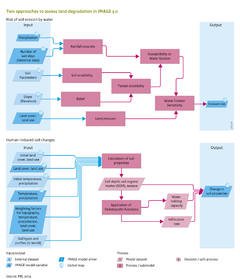Land degradation: Difference between revisions
Jump to navigation
Jump to search
Oostenrijr (talk | contribs) m (Text replace - "Initial temperature, precipitation" to "Initial temperature, precipitation - grid") |
Oostenrijr (talk | contribs) m (Text replace - "Initial land cover, land use" to "Initial land cover, land use - grid") |
||
| Line 6: | Line 6: | ||
|Reference=FAO, 2011a; Wischmeier and Smith, 1978; Nkonya et al., 2011; Bindraban et al., 2012; UNCCD, 2012; Rozanov et al., 1990; | |Reference=FAO, 2011a; Wischmeier and Smith, 1978; Nkonya et al., 2011; Bindraban et al., 2012; UNCCD, 2012; Rozanov et al., 1990; | ||
|InputVar=Precipitation - grid; Number of wet days - grid; Land cover, land use - grid; Temperature - grid; | |InputVar=Precipitation - grid; Number of wet days - grid; Land cover, land use - grid; Temperature - grid; | ||
|Parameter=Slope - grid; Initial land cover, land use; Initial temperature, precipitation - grid; Soil types and profiles (S-World); Weighting factors for temperature, precipitation, land use and slope; | |Parameter=Slope - grid; Initial land cover, land use - grid; Initial temperature, precipitation - grid; Soil types and profiles (S-World); Weighting factors for temperature, precipitation, land use and slope; | ||
|OutputVar=Erosion risk - grid; Change in soil properties - grid; | |OutputVar=Erosion risk - grid; Change in soil properties - grid; | ||
|Description=Land degradation is human-induced damage to ecosystems leading to a sustained loss of capacity. This is a serious and widespread problem leading ultimately to loss of arable land, and to demand for new arable land to compensate for decline in production on existing land. A key symptom of land degradation is loss of organic carbon from soils and vegetation, also contributing to global greenhouse gas emissions. The key mechanisms in land degradation are soil erosion (by water and wind), compaction, salinization, nutrient depletion, structural decay and contamination. The main causes are deforestation, land conversion, inadequate agricultural land use and management, and construction (urbanisation, road construction). | |Description=Land degradation is human-induced damage to ecosystems leading to a sustained loss of capacity. This is a serious and widespread problem leading ultimately to loss of arable land, and to demand for new arable land to compensate for decline in production on existing land. A key symptom of land degradation is loss of organic carbon from soils and vegetation, also contributing to global greenhouse gas emissions. The key mechanisms in land degradation are soil erosion (by water and wind), compaction, salinization, nutrient depletion, structural decay and contamination. The main causes are deforestation, land conversion, inadequate agricultural land use and management, and construction (urbanisation, road construction). | ||
Revision as of 16:56, 18 June 2014
Parts of Land degradation
| Component is implemented in: |
|
| Related IMAGE components |
| Projects/Applications |
| Models/Databases |
| Key publications |
| References |
Key policy issues
- In what parts of the world have human-induced changes in land and soil conditions occurred?
- What are the future risks of soil degradation?
- To what extent are ecosystem functions lost by soil degradation, adding to local and global concerns about food security, biodiversity loss and climate change?
